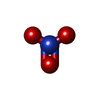+検索条件
-Structure paper
| タイトル | Hydrogens and hydrogen-bond networks in macromolecular MicroED data. |
|---|---|
| ジャーナル・号・ページ | J Struct Biol X, Vol. 6, Page 100078, Year 2022 |
| 掲載日 | 2022年11月10日 |
 著者 著者 | Max T B Clabbers / Michael W Martynowycz / Johan Hattne / Tamir Gonen /  |
| PubMed 要旨 | Microcrystal electron diffraction (MicroED) is a powerful technique utilizing electron cryo-microscopy (cryo-EM) for protein structure determination of crystalline samples too small for X-ray ...Microcrystal electron diffraction (MicroED) is a powerful technique utilizing electron cryo-microscopy (cryo-EM) for protein structure determination of crystalline samples too small for X-ray crystallography. Electrons interact with the electrostatic potential of the sample, which means that the scattered electrons carry information about the charged state of atoms and provide relatively stronger contrast for visualizing hydrogen atoms. Accurately identifying the positions of hydrogen atoms, and by extension the hydrogen bonding networks, is of importance for understanding protein structure and function, in particular for drug discovery. However, identification of individual hydrogen atom positions typically requires atomic resolution data, and has thus far remained elusive for macromolecular MicroED. Recently, we presented the structure of triclinic hen egg-white lysozyme at 0.87 Å resolution. The corresponding data were recorded under low exposure conditions using an electron-counting detector from thin crystalline lamellae. Here, using these subatomic resolution MicroED data, we identified over a third of all hydrogen atom positions based on strong difference peaks, and directly visualize hydrogen bonding interactions and the charged states of residues. Furthermore, we find that the hydrogen bond lengths are more accurately described by the inter-nuclei distances than the centers of mass of the corresponding electron clouds. We anticipate that MicroED, coupled with ongoing advances in data collection and refinement, can open further avenues for structural biology by uncovering the hydrogen atoms and hydrogen bonding interactions underlying protein structure and function. |
 リンク リンク |  J Struct Biol X / J Struct Biol X /  PubMed:36507068 / PubMed:36507068 /  PubMed Central PubMed Central |
| 手法 | EM (電子線結晶学) |
| 解像度 | 0.87 Å |
| 構造データ | EMDB-26596, PDB-7uly: |
| 化合物 |  ChemComp-NO3:  ChemComp-HOH: |
| 由来 |
|
 キーワード キーワード | HYDROLASE |
 ムービー
ムービー コントローラー
コントローラー 構造ビューア
構造ビューア 万見文献について
万見文献について






